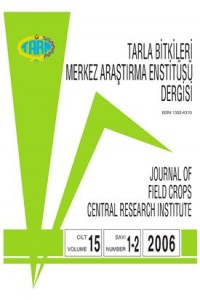Öz
The demand of water is increasing day by day because of global warming and world population increase. Available water resources is diminishing. The major consumer of fresh water resources is agriculture sector. Because of that, increase of the water use efficiency in agriculture has become an urgency. Drip irrigation method is the most efficient one within the methods which using water in effective way.
To get expected benefit from drip irrigation depends on projects designed and managed carefuly by the trained specialists and carefully running the drip irrigation. The system should be carried out and processed as suggested in the project. The first investing expenses of the drip irrigation is high and carrying out of drip irrigation requires too much data and skill. Therefore farmers should be informed about management of drip irrigation systems and they should be made conscious of the system. So the use of the system will be more effective and productive.
Anahtar Kelimeler
Drip irrigation; water resources; fresh water resources; global warming
Kaynakça
- Anonim 2005. “Sulama” Tarım ve Köyişleri Bakanlığı Teşkilatlanma ve Destekleme genel Müdürlüğü Yayım Dairesi Başkanlığı, Yayın no : 42. Ankara
- Anonim 2007. “2006 Yılı DSİ’ce İşletilen ve Devredilen Sulama Tesisleri Değerlendirme Raporu”. DSİ Gn. Md., İşletme ve Bakım Dairesi Başkanlığı, Ankara. 482 s.
- Çamoğlu, Y., Yavuz, M., 2006. Boruya içten geçik(in-line) ve dıştan geçik(on-line) damlatıcılarda yapım farklılığı katsayısının sulama yeknesaklığına etkisi. Akdeniz Üniversitesi Ziraat Fakültesi Dergisi,2006, 19(1), 1-8. Antalya.
- Çetin, Ö., 2004. “Tarımsal Sulama Yöntemler” Tarım Köy İşleri Bakanlığı, Yayın Dairesi Başkanlığı. No: 2004/7, Ankara.
- Çetin, Ö., Uygan, D., boyacı, H., 2006. Damla Sulama Yönteminde Farklı Lateral Aralıkları ve Islatma Alanı Yüzdelerinin Domateste Verim ve Su Kullanımı Randımanına Etkisi. Proje no: KHGM-03220E01. Eskişehir.
- Eroğlu,V.,2003. Gelecek İçin Su. Dünya Su Günü, Ankara.
- Kanber, R., Çakır, R., Tarı, F., 2003. Sulama ve Drenaj Mühendisliği, KGHM, APK D. Bşk, yayın no : 122, Ankara.
- Nakayama, F.S., Bucks, D.A., 1981. Temperature effects on calcium carbonete precipitate clogging of trickle emitters, US Water Cons.Lab. Phoenix, USA.
- Şener, S., Ertaş, R., Öğretir, K., Apan, A., 1995. Türkiyede Sulanan Bitkilerin Sulama Teknikleri. KGHM. APK Daire Bşk. Yayın no : 89. Menemen.
- Westarp,S., Chieng, S., Schreier, H., 2003. A comparison between low-cost drip irrigation, conventional drip irrigation, and hand watering in Nepal. Agricultural Water Management 64 (2004) 143-160.
- Yıldırım, O., Güngör, Y., Erözel, Z., 2004. Sulama. A.Ü. Ziraat Fakültesi, Tarımsa Yapılar ve Sulama Bölümü, Ankara.
Öz
Dünya nüfusundaki artış ve küresel ısınmanın da etkileriyle azalan su kaynaklarına olan talep gün geçtikçe artmaktadır. Kullanılabilir nitelikteki su kaynakları azalmaktadır. Tatlı su kaynaklarının en büyük kullanıcısı tarım sektörüdür. Bu yüzden tarımda kullanılan suyun etkinliğinin artırılması bir zorunluluk haline gelmiştir. Damla sulama, sulama yöntemleri içerisinde suyu en etkili şekilde kullanan yöntemlerden birisidir.
Damla sulama sistemlerinden beklenen yararın elde edilebilmesi, konusunda eğitim almış uzman kişilerce projelendirilmesine ve iyi bir şekilde işletilmesine bağlıdır. Sistem projede öngörüldüğü şekilde araziye uygulanmalı ve işletilmelidir. Damla sulama yöntemi ilk yatırım masrafları yüksek, kullanımı daha fazla bilgi ve beceri istemektedir. Bu yüzden damla sulama yönteminin işletimi hakkında üreticiye gerekli bilgiler verilmeli ve bilinçlendirilmelidir. Böylece sistemlerin daha etkin ve verimli kullanılması sağlanacaktır.
Anahtar Kelimeler
Damla sulama; su kaynakları; tatlı su kaynakları; sulama; küresel ısınma
Kaynakça
- Anonim 2005. “Sulama” Tarım ve Köyişleri Bakanlığı Teşkilatlanma ve Destekleme genel Müdürlüğü Yayım Dairesi Başkanlığı, Yayın no : 42. Ankara
- Anonim 2007. “2006 Yılı DSİ’ce İşletilen ve Devredilen Sulama Tesisleri Değerlendirme Raporu”. DSİ Gn. Md., İşletme ve Bakım Dairesi Başkanlığı, Ankara. 482 s.
- Çamoğlu, Y., Yavuz, M., 2006. Boruya içten geçik(in-line) ve dıştan geçik(on-line) damlatıcılarda yapım farklılığı katsayısının sulama yeknesaklığına etkisi. Akdeniz Üniversitesi Ziraat Fakültesi Dergisi,2006, 19(1), 1-8. Antalya.
- Çetin, Ö., 2004. “Tarımsal Sulama Yöntemler” Tarım Köy İşleri Bakanlığı, Yayın Dairesi Başkanlığı. No: 2004/7, Ankara.
- Çetin, Ö., Uygan, D., boyacı, H., 2006. Damla Sulama Yönteminde Farklı Lateral Aralıkları ve Islatma Alanı Yüzdelerinin Domateste Verim ve Su Kullanımı Randımanına Etkisi. Proje no: KHGM-03220E01. Eskişehir.
- Eroğlu,V.,2003. Gelecek İçin Su. Dünya Su Günü, Ankara.
- Kanber, R., Çakır, R., Tarı, F., 2003. Sulama ve Drenaj Mühendisliği, KGHM, APK D. Bşk, yayın no : 122, Ankara.
- Nakayama, F.S., Bucks, D.A., 1981. Temperature effects on calcium carbonete precipitate clogging of trickle emitters, US Water Cons.Lab. Phoenix, USA.
- Şener, S., Ertaş, R., Öğretir, K., Apan, A., 1995. Türkiyede Sulanan Bitkilerin Sulama Teknikleri. KGHM. APK Daire Bşk. Yayın no : 89. Menemen.
- Westarp,S., Chieng, S., Schreier, H., 2003. A comparison between low-cost drip irrigation, conventional drip irrigation, and hand watering in Nepal. Agricultural Water Management 64 (2004) 143-160.
- Yıldırım, O., Güngör, Y., Erözel, Z., 2004. Sulama. A.Ü. Ziraat Fakültesi, Tarımsa Yapılar ve Sulama Bölümü, Ankara.
Ayrıntılar
| Birincil Dil | Türkçe |
|---|---|
| Bölüm | Makaleler |
| Yazarlar | |
| Yayımlanma Tarihi | 1 Haziran 2006 |
| Yayımlandığı Sayı | Yıl 2006 Cilt: 15 Sayı: 1-2 |


